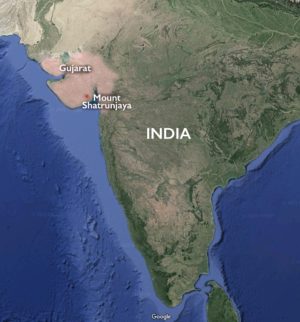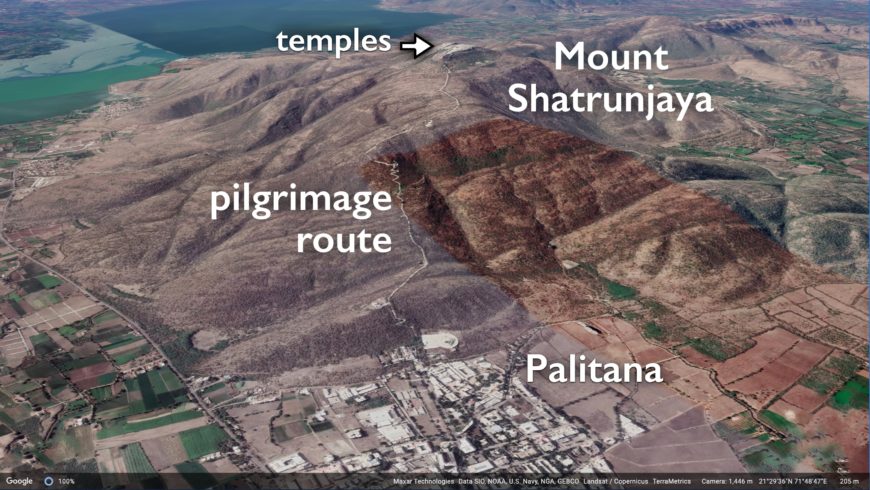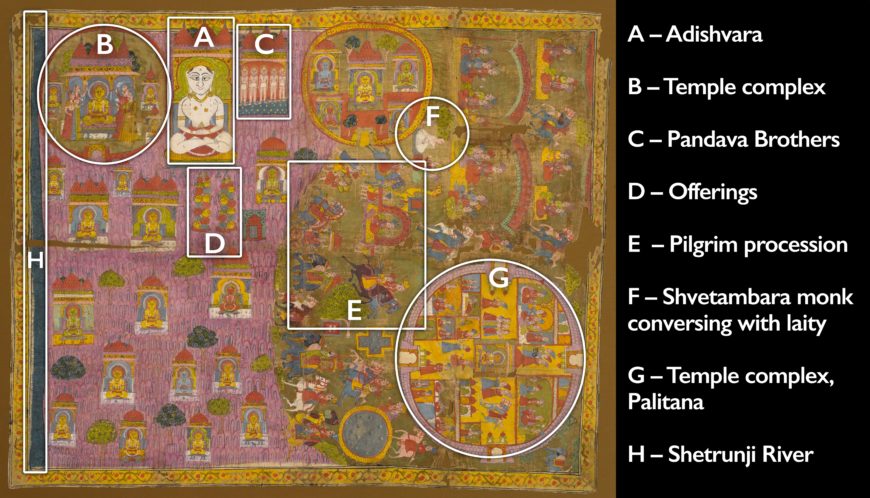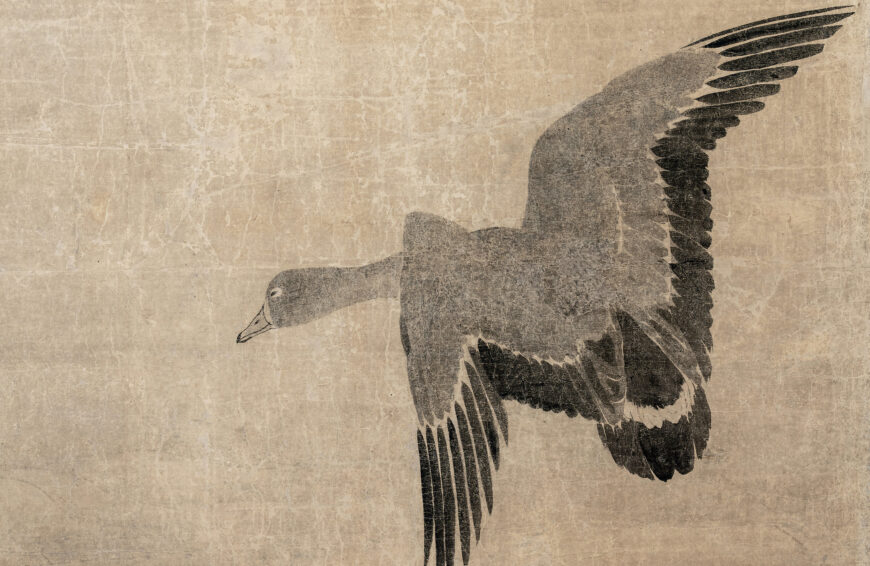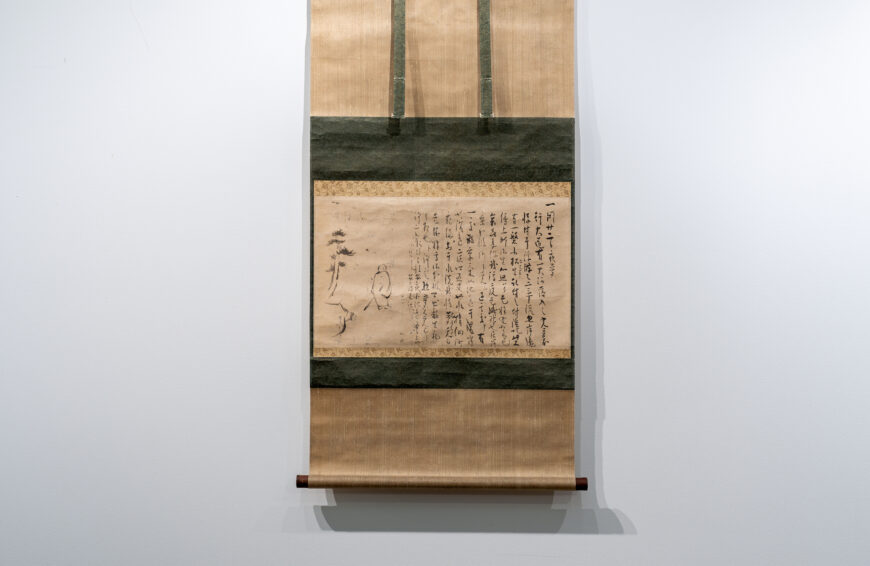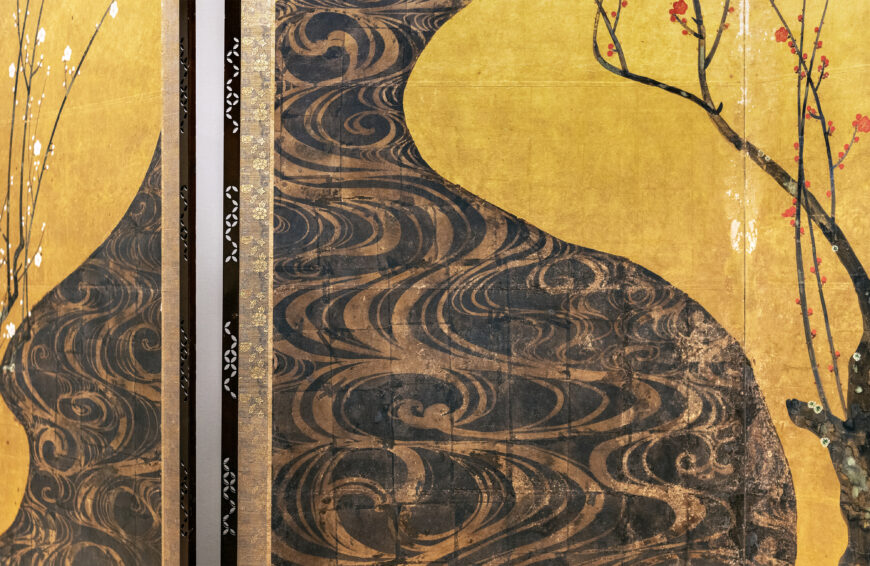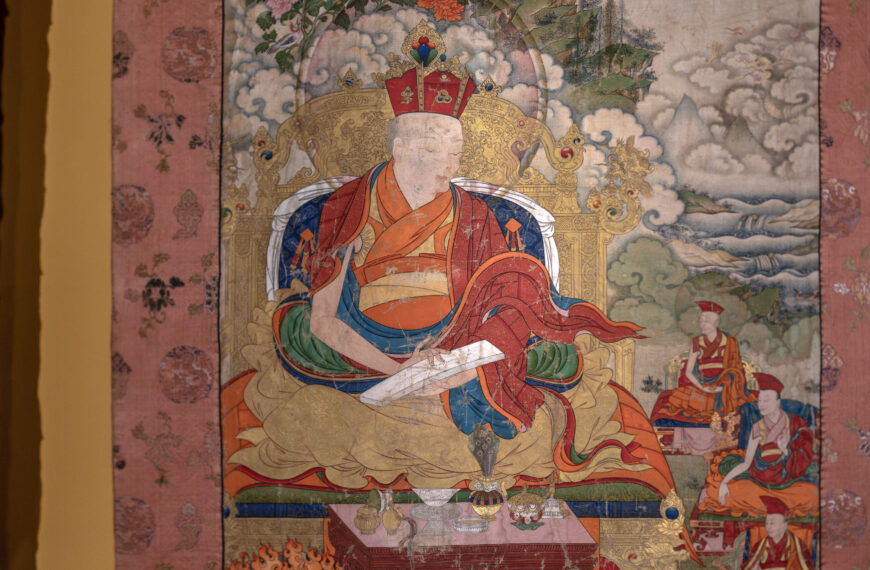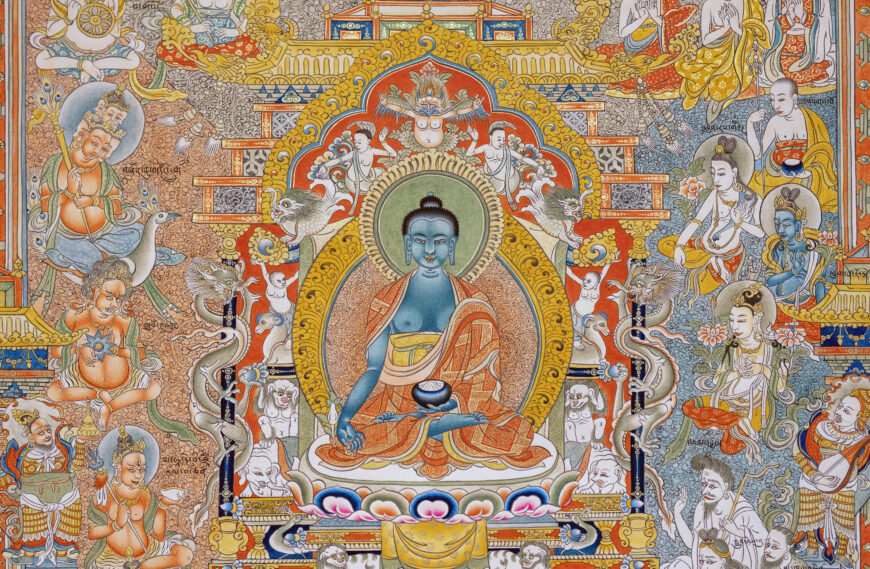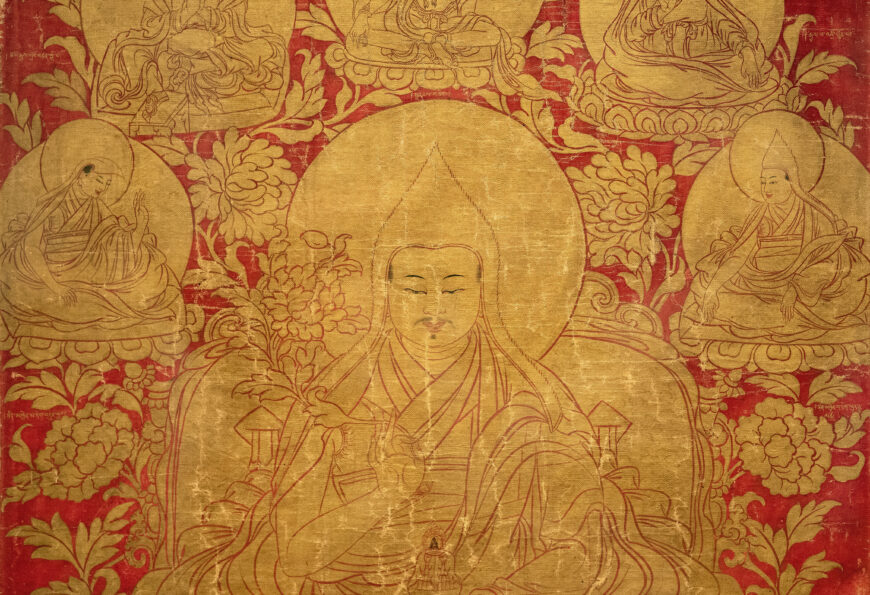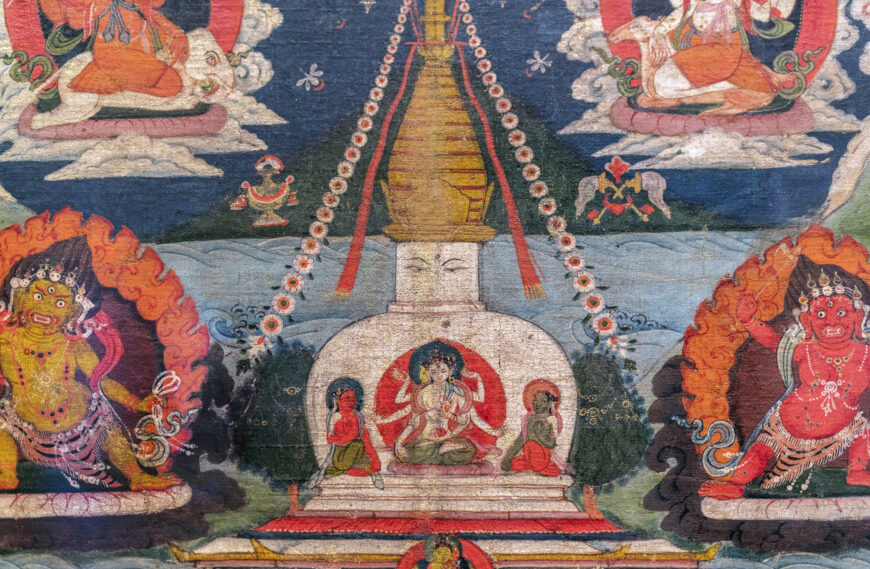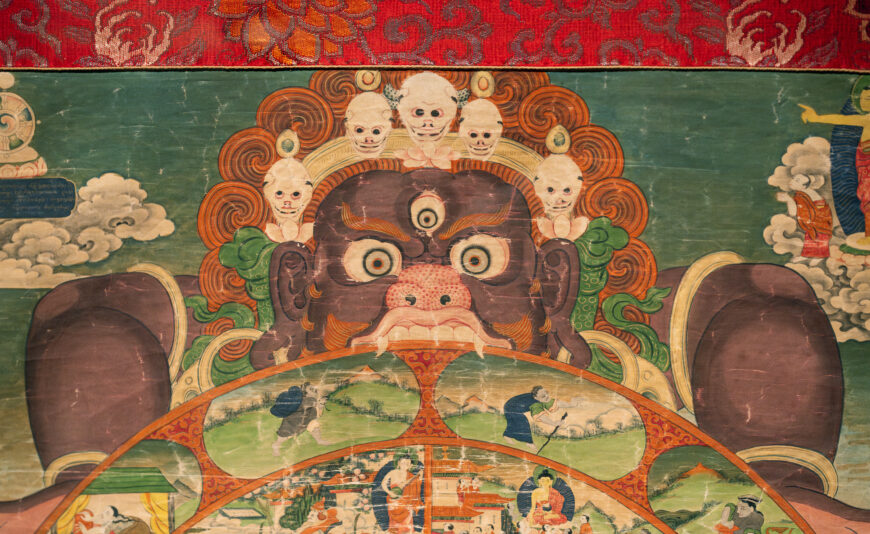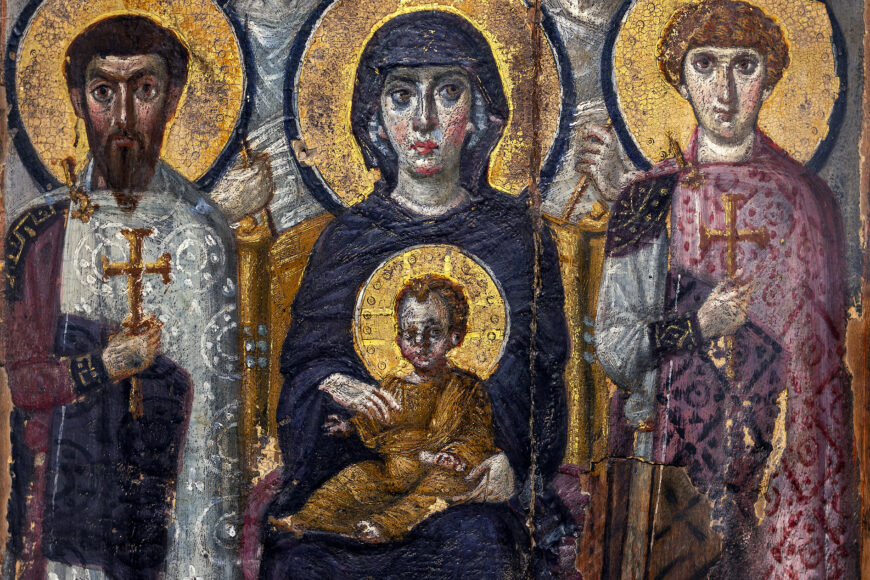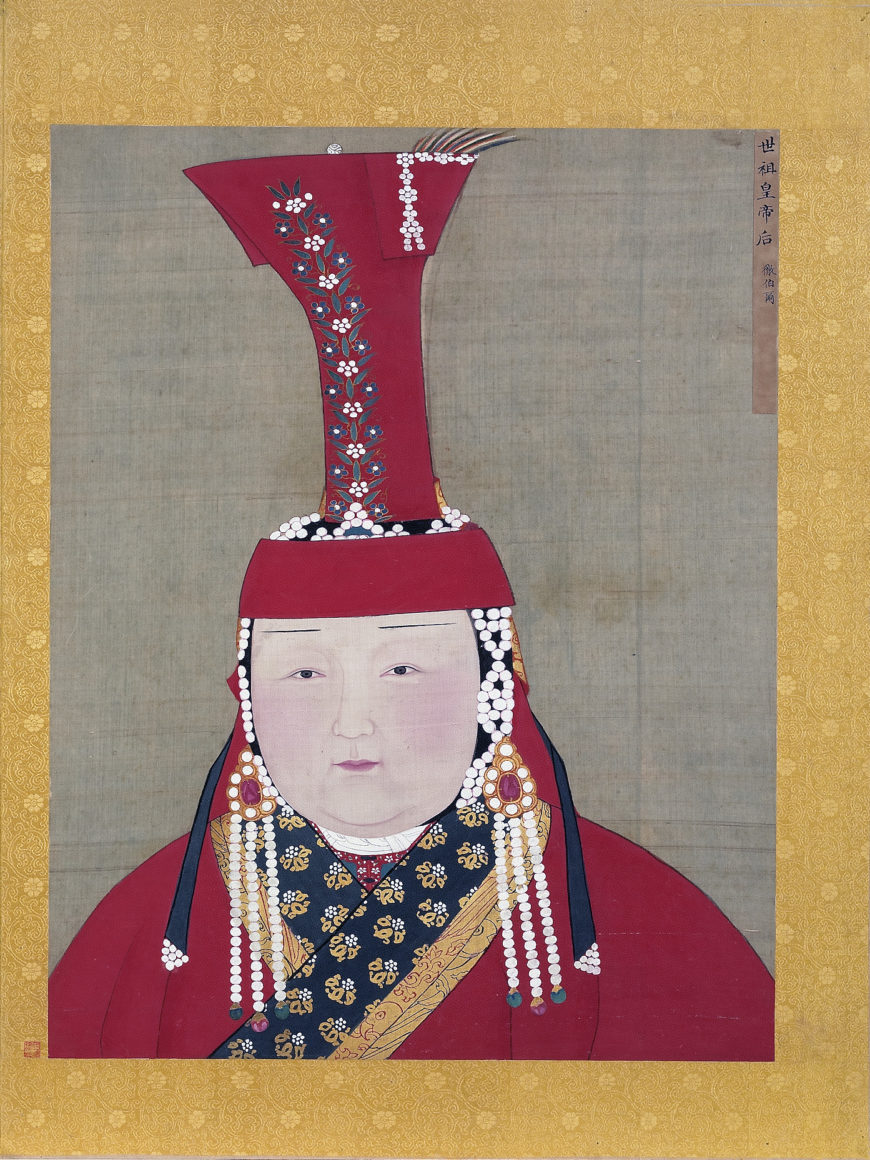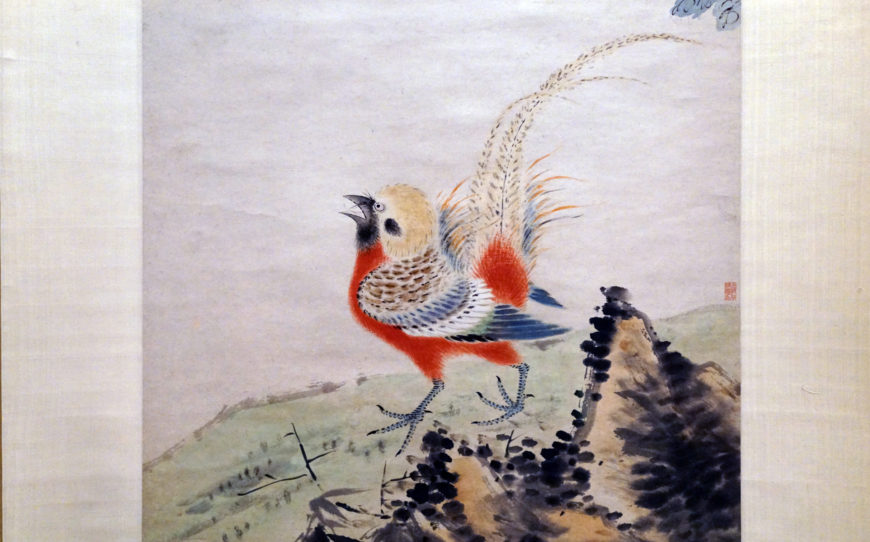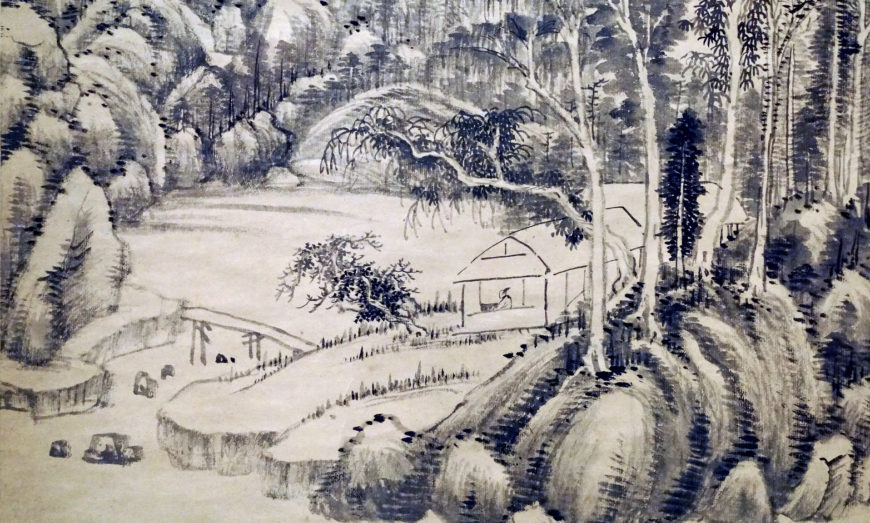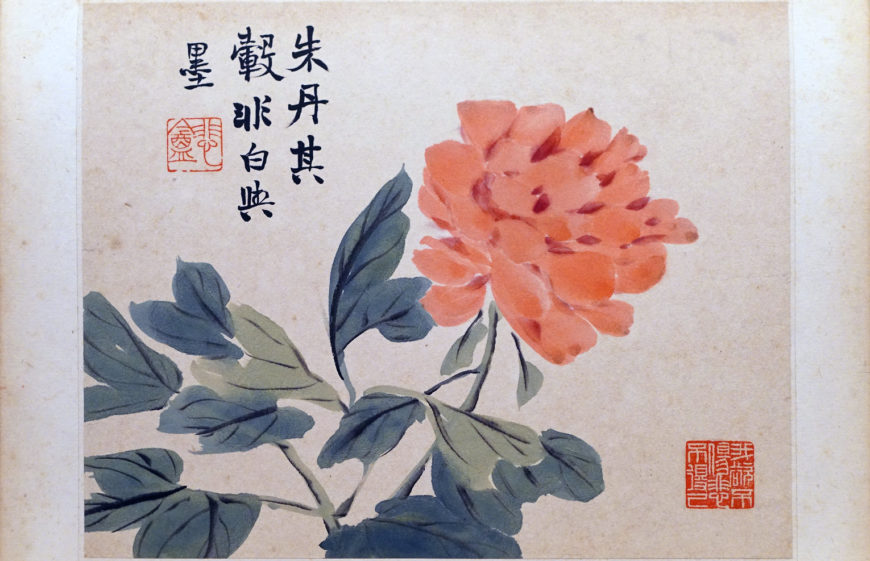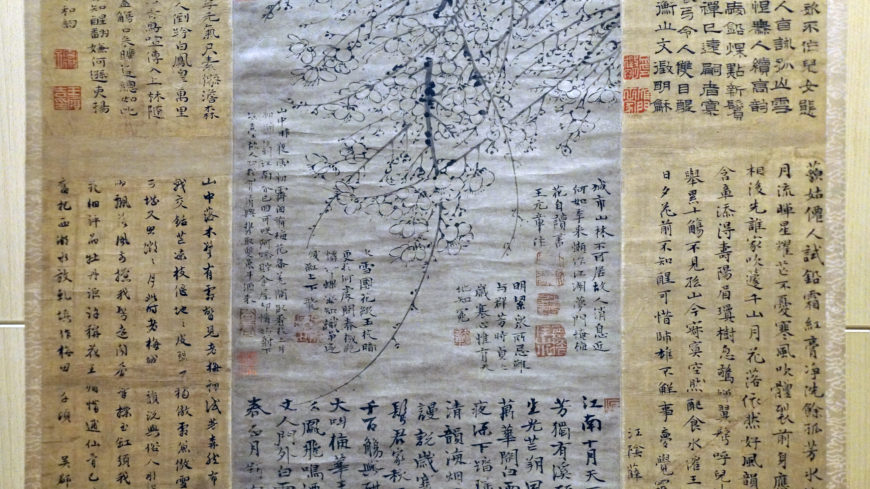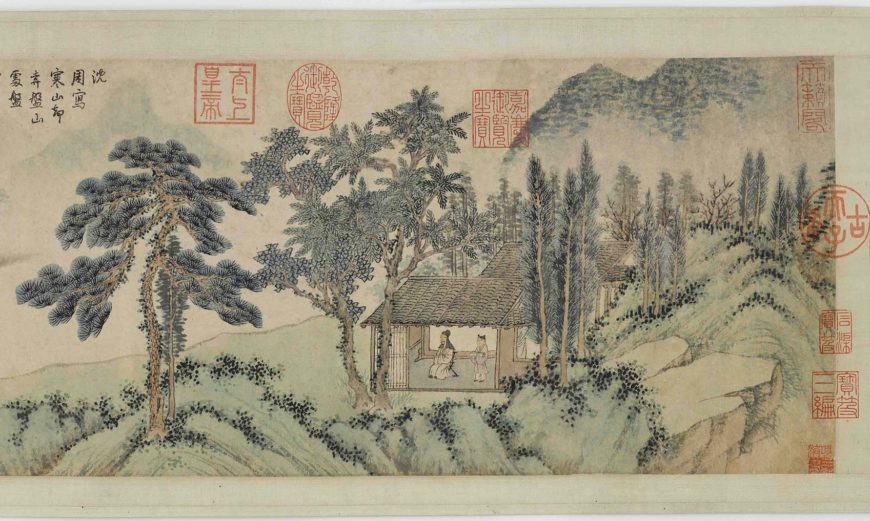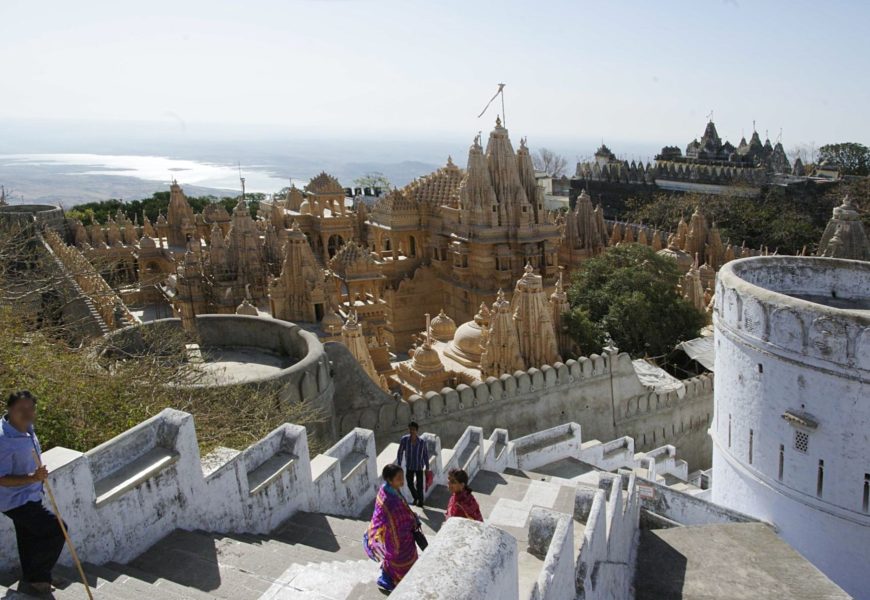
Mount Shatrunjaya, Palitana, Gujarat, India (photo: Kman85, CC BY-SA 4.0)
A temple city
More than a thousand shrines are found nestled on the twin summits of Mount Shatrunjaya in northwest India. For more than a millennium, this temple city—which offers stunning views of the surrounding landscape—has been built and rebuilt, and is one of the most revered pilgrimage sites for Jains.
Shatrunjaya is mentioned in Jain texts from the 5th century C.E. onwards but gained prominence in medieval literature—a period which also saw proliferation of building activity at the site. [1] The site is especially revered by the image-worshipping branch of Shvetambara Jains, who are required to visit at least once in a lifetime. It bustles with pilgrims but becomes serene as night falls because no one is allowed to remain at the sacred site overnight.
Paintings on cloth (patas) that mapped the topography of sacred Jain pilgrimage sites (tirthas)—called tirtha patas—started making an appearance in visual art beginning in the 15th century but monumental paintings solely devoted to one tirtha—specially Shatrunjaya (Shatrunjaya patas)—became increasingly popular in the 18th and 19th centuries. Large in scale so all details would be easily visible, pilgrimage patas were of great significance for those unable to make the physical journey as they offered a chance for mental pilgrimage.
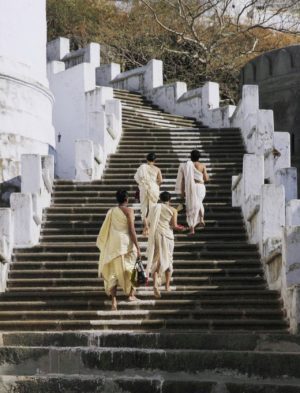
Pilgrims (monks in this photo) ascending to Shatrunjaya from Palitana (photo: Andrea Kirby, CC BY-NC 2.0)
The importance of pilgrimage for Jains
For Jains, pilgrimage is a ritual commemorating the enlightenment or liberation of Jinas and other saintly figures. Shatrunjaya holds a special place for Jains because of its close affinity with the first Jina, Adishvara. Jain pilgrimage sites, mostly on hills, are spread all across India but five (including Shatrunjaya), are believed to be the most sacred.
A Shatrunjaya Pata
A pilgrimage map from c. 1750 in the collection of the Brooklyn Museum presents Shatrunjaya in unique multi-perspective that prompts the viewer to shift their viewpoint to take in all the details. The map highlights important aspects of the site and offers a window into the Jain world and the significance of both pilgrimage and charity.

Jain pilgrimage map, c. 1750, Rajasthan, opaque watercolor and gold on cotton, 77 x 96 cm (Brooklyn Museum)
On the left side of the map we see the temple city of Shatrunjaya on a hill as evident from the shrines scattered across the pink rocky outcrops. Patas (cloth paintings) like this one were generally hung up on temple walls for public viewing and veneration. For that reason they were large (some later patas were up to or more than a meter in height and width) so that all the details of the sacred landscape would be clearly visible. In this map however, the viewer has to turn their head to see the town of Palitana which lies at the foot of the mountain (“G” in the diagram below). In the pata, pilgrims seem to begin the steep ascent to Shatrunjaya from the temple complex there. This map is also unique in its representation of Palitana (and the area around it, depicted in green) beside the mountain, instead of below it.
The walled temple complex in Palitana (seen in the lower right corner—”G” in the diagram above) appears in the shape of a Samavasarana, a three-tiered structure with four gateways in cardinal directions, constructed by the gods whenever a Jina achieves enlightenment and preaches to all living beings. Enlightenment of the Jinas is amongst the five auspicious events celebrated by the Jains (the other auspicious events are the Jina’s conception, birth, renunciation and liberation—all common subjects in Jain art).
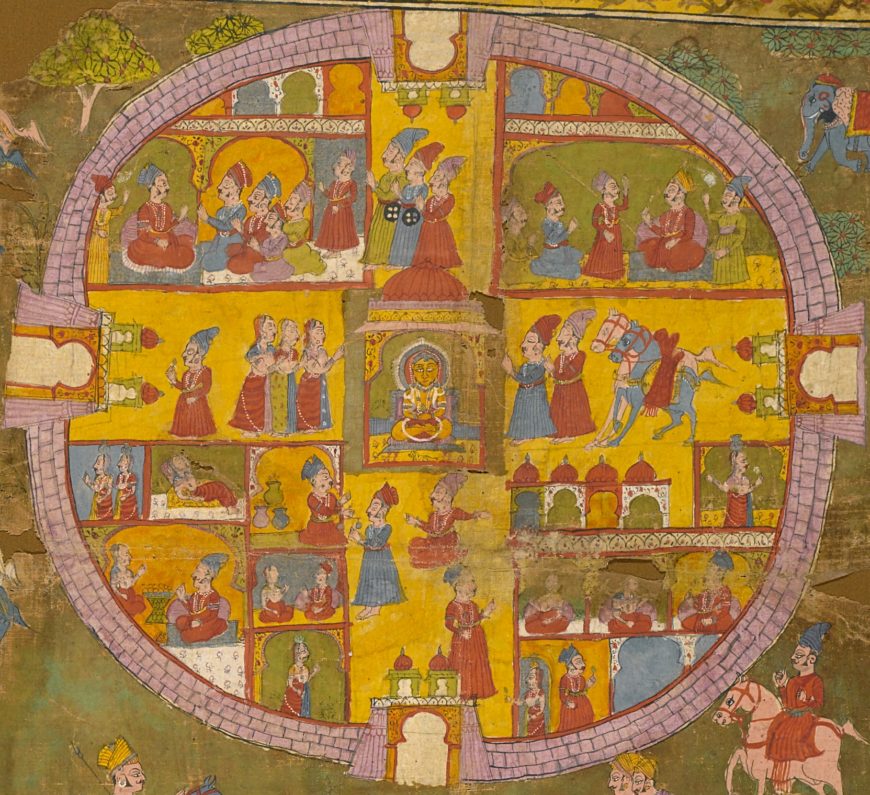
Detail, walled temple complex of Palitana (“G” in the diagram above). Jain pilgrimage map, c. 1750, Rajasthan, opaque watercolor and gold on cotton, 77 x 96 cm (Brooklyn Museum)
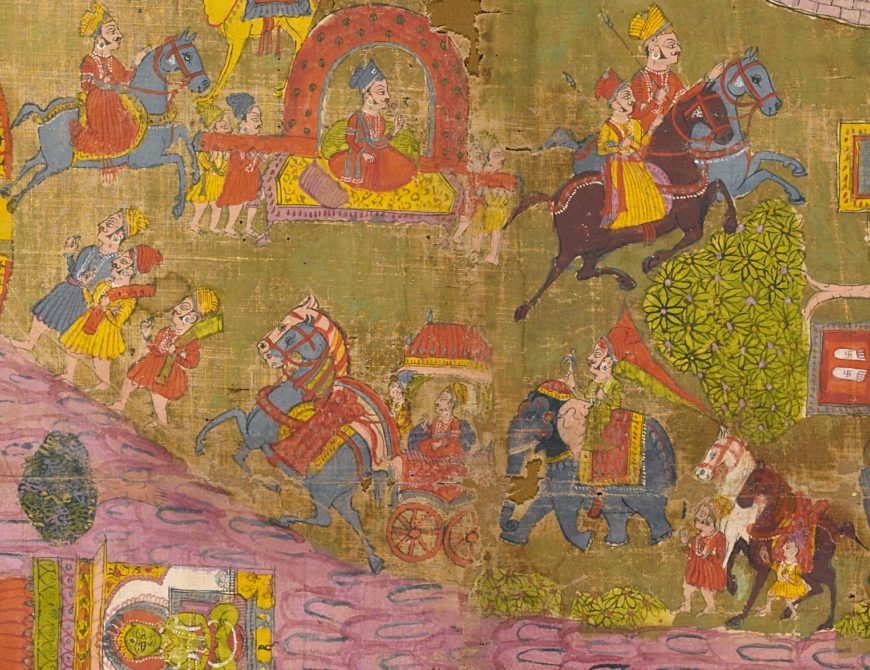
The grand pilgrim procession (“E” in the diagram above) ascending the steep mountainside with elephant riders and horse-drawn carts. Jain pilgrimage map, c. 1750, Rajasthan, opaque watercolor and gold on cotton, 77 x 96 cm (Brooklyn Museum)
Near the center of the map, we see a grand procession of pilgrims (“E” in the diagram above) with elephant riders and horse-drawn carts. This marks a divide on the map between the comparatively sparse, peaceful, sacred mountain with its temples on the left side of the composition and the town at the foothills to the right that bustles with activity. The carts and elephants we see in the procession would be left at the base of the mountain because the ascent up the mountain had to be made on foot (or in a palanquin for the elderly and disabled). On the far left we see the river Shetrunji represented in dark blue with a basket-weave pattern denoting water (“H” in the diagram above).

Seated Adishvara at the apex of the hill covered with temple complexes, to the right are the Pandava brothers, and to the left Adishvara temple. A, B, and C in the Jain pilgrimage map above, c. 1750, Rajasthan, opaque watercolor and gold on cotton, 77 x 96 cm (Brooklyn Museum)
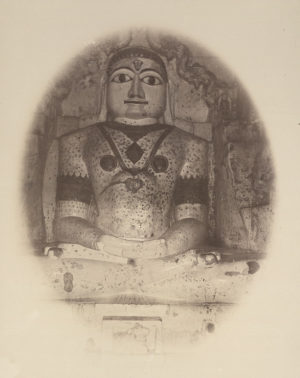
Photograph of Shatrunjaya (Sykes and Dwyer, photographic print in James Burgess, The Temples of Satrunjaya, the celebrated Jain place of pilgrimage, 1869, The British Library)
On the left side, the hill with its temple complexes is dominated at the apex of the composition by a meditative figure sitting within a shrine (“A” in the diagram above). This is an image of Adishvara, the first Jina. Popularly called Adibuddhaji, this is the largest rock-cut sculpture (18-feet tall) at the site and appears on most patas commissioned after its installation in 1630 C.E. [2] It is believed that it was at Shatrunjaya that Adishvara delivered his first sermon. His son Bharata, who achieved liberation here, is said to have erected the first Jain temple at Shatrunjaya.
![ykes and Dwyer, Front of the Temple of Adisvara Bhagavana [Satrunjaya], 1869, photographic print (The British Library)](https://smarthistory.org/wp-content/uploads/2021/04/Front-of-the-Temple-of-Adisvara-Bhagavana-Satrunjaya-.jpg)
Front of the Temple of Adisvara Bhagavana [Satrunjaya] (Sykes and Dwyer, photographic print in James Burgess, The Temples of Satrunjaya, the celebrated Jain place of pilgrimage, 1869, The British Library)
To the left of the figure of Adishvara, we see the Adishvara temple, the most sacred temple complex at the site (“B” in the diagram above). Here, Adishvara is venerated by men and women who gaze upon him to seek darsana while respectfully waving a fly whisk over his head. Worship is offered to any Jina with the understanding that he cannot grant fulfillment of worldly desires in return. The purpose, however, is spiritual transformation of the devotee who is reminded of the goal of liberation and the path to achieving that when in the presence of the Jina. [3]
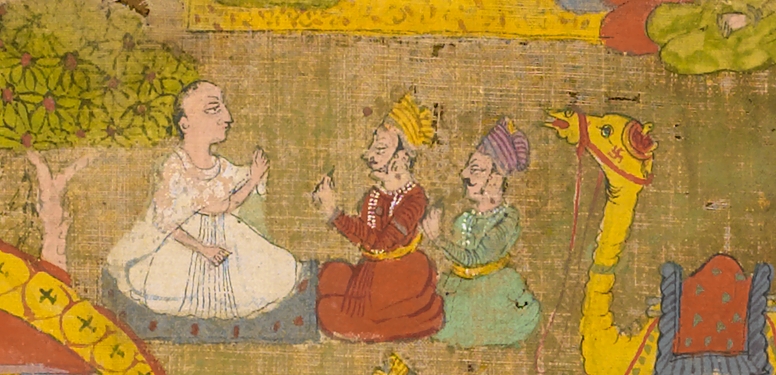
A white robed monk in discussion with attentive laymen (“F” in the diagram above). Jain pilgrimage map, c. 1750, Rajasthan, opaque watercolor and gold on cotton, 77 x 96 cm (Brooklyn Museum)
The pata also highlights the close interaction between monks and pilgrims. We see a white robed monk in discussion with attentive laymen (“F” in the diagram above). Being true renouncers (having renounced all worldly attachments and possessions), monastics are considered role models and such scenes of religious instruction occur repeatedly in Jain art testifying to the close bond between the monastic and lay community.
Pilgrimage and religious giving
All Jains are expected to follow the path prescribed by the Jinas. This includes belief in and acting by the “three jewels” of right faith, right knowledge, and right conduct. It also means adhering to the five vows of non-violence, truth, not taking what is not given, celibacy, and non-possession. However, these vows are relaxed for the laity since for them complete renunciation, celibacy, and non-possession is not possible. Instead, the laity strive to lead a life of simple well-being and for them the vow of non-possession translates to a focus on religious giving in the form of alms, temple building, installation of images, copying manuscripts, organizing and going on pilgrimage, and veneration of the Jina and ascetics.
Charity—also a means of earning religious merit and negating the effect of accruing karmic particles due to worldly actions—contributed to a large number of temples and icons being dedicated on the site by rich merchants and noblemen. [4]
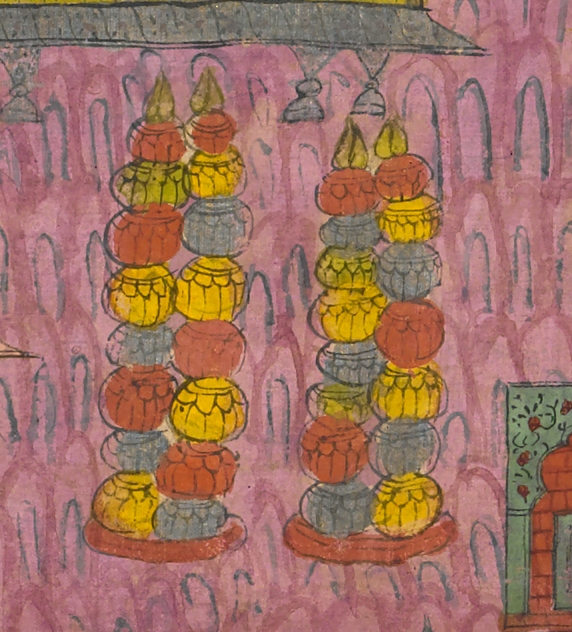
Towers of pots (“D” in the diagram above) meant to represent offerings donated by the Jain minister Vastupala in the 13th century. Jain pilgrimage map, c. 1750, Rajasthan, opaque watercolor and gold on cotton, 77 x 96 cm (Brooklyn Museum)
The stacked pots (“D” in the diagram above) seen in the pata are examples of charitable giving (along with temples and icons). They represent the abundant offerings donated by the Jain minister Vastupala in the 13th century. [5]
The duration of pilgrimage also offered an opportunity for the Jain laity to emulate the life of ascetics by taking temporary vows of eating once a day, sleeping on the ground, walking barefoot, having deep faith in Jainism, eating food that does not involve karmic harm, and celibacy. [6]
Pilgrimage therefore helped the laity attain spiritual purification by venerating Jinas as well as fulfilling the duty of religious giving while gaining religious merit in the act itself. For monks, pilgrimage lent a structure to their wanderings which were often planned along pilgrimage routes.
Significance of pilgrimage patas
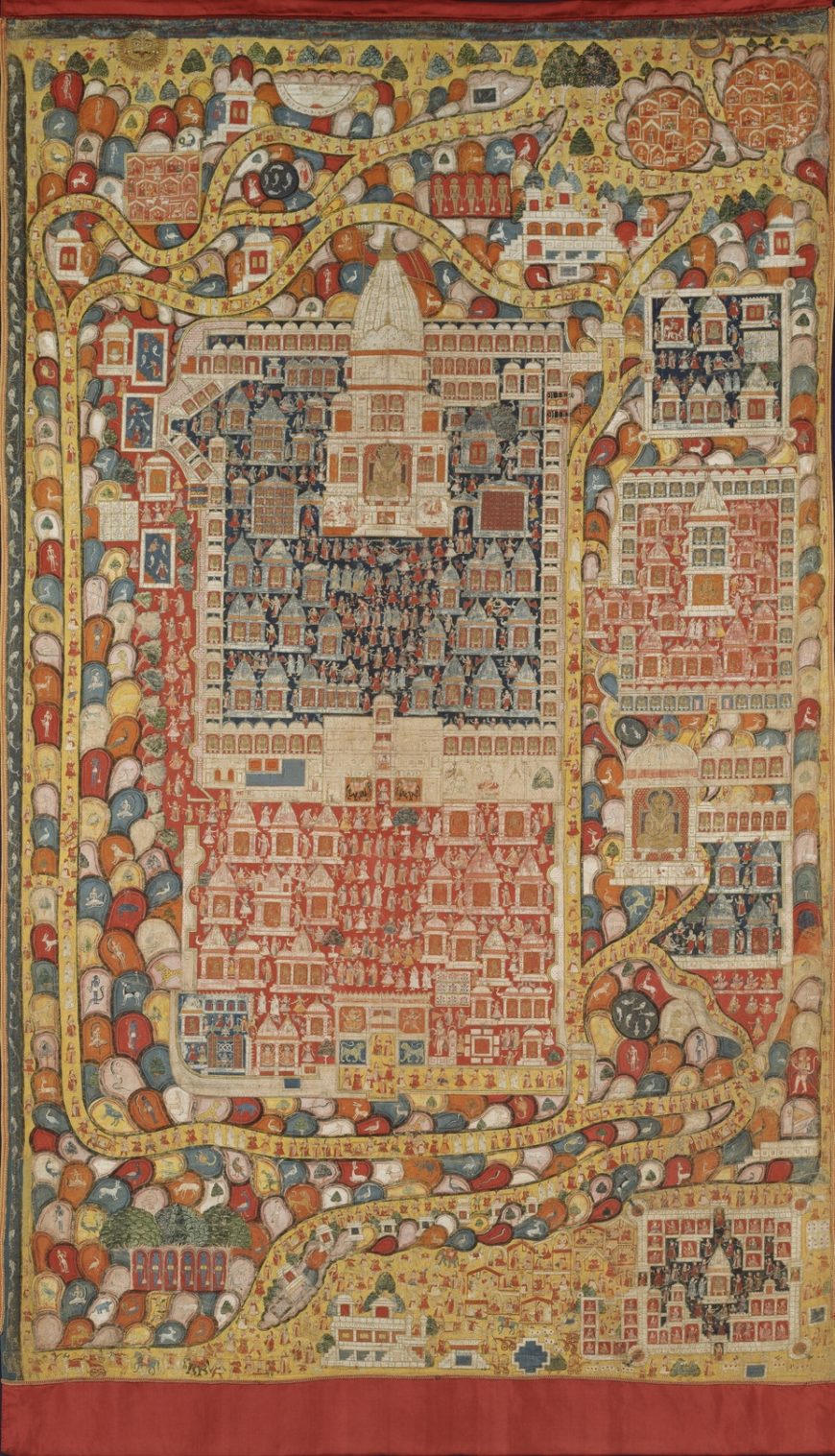
Adishvara in this pata is the largest gilded icon (see the detail) below the temple complex in red background on the right. Shatrunjaya tirtha pata, c. 1800, painting on cloth, gouache, Gujarat, height: 320 cm, width: 194 cm (Ethnographic collection-Asia, MAS Antwerp)
With increasing patronage and building activity, Shatrunjaya patas commissioned by wealthy Jains became increasingly popular in the 18th and 19th centuries. Some of these bear very close topographical resemblance to the site. For example, a monumental Shatrunjaya pata dated c. 1800 presents a striking contrast in its cartographic and accurate description of the temples on both mountain summits.
Once a year, often towards the end of the rainy season retreat, these monumental paintings were hung up in temples for devotees to worship and earn religious merit. Such an act was believed to carry as much sanctity as the physical journey itself. Pilgrimage patas therefore are not just a visual delight but venerated objects serving multiple functions.


